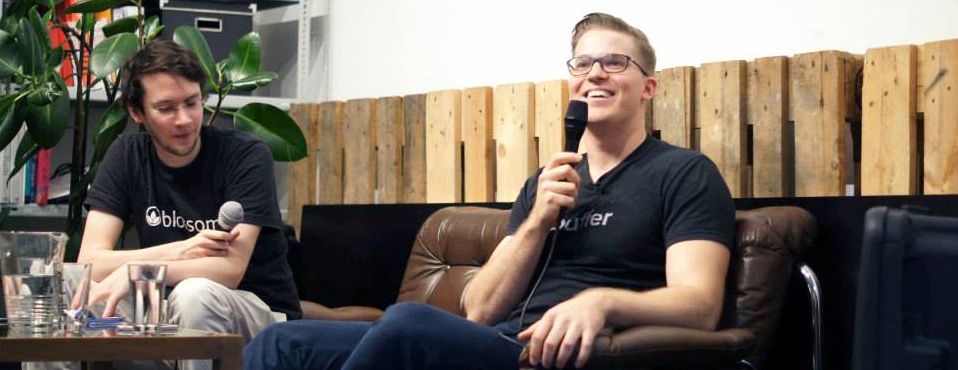
13 Big Questions about Buffer’s Culture and Transparency, Answered
Former Director of People @ Buffer
Towards the end of 2014, Buffer co-founder Leo Widrich came back to his family home in Austria for a visit and was able to join the coworking community space sektor5 for a fireside chat about Buffer’s culture, values, transparency and lots more.
The audience at this event asked tons of smart questions, so we thought it would be fun to share the answers with you here.
What’s Buffer? Where are you right now?
Leo: We are a social media management tool. We help people to publish, schedule and analyze their posts when they post to social media. To Twitter, Facebook, LinkedIn, Google+. We help individuals to do that, we help companies do that.
Where are we now? We’re about 30 people across the globe. We’ve just recently closed a funding round. The company has validation at around $60M dollars. That’s a short overview.
How does Buffer make money?
Leo: Buffer makes money by awesome people paying for the Buffer paid plans to better manage their social media accounts. The most popular subscription is the Buffer Awesome plan at $10/mo together with the Buffer Business plans starting at $50/mo. Together they make up the total revenue Buffer generates.
What is your role at Buffer and how has it changed over time?

Leo: At the very beginning of Buffer I was more like the intern. I was going to university in the UK and trying to do stuff like build a startup, build different products. I had a great mentor at that time and that mentor was Joel Gascoigne.
He helped me and he was building another product at that time called OnePage. He was helpful whenever I was trying to get my own projects off the ground and I was always asking for help. “How does this look? How can I work on this? How can I build this?” I’m not technical, I hacked things together with WordPress and stuff.
Joel himself was building this thing on the side called Buffer. We were chatting on Skype one day and I was probably asking for help on some stuff I was working on. And then I was like “How is it going on your side?” as I remember he was trying to build this side project Buffer and he said: “Buffer is going great, I’ve launched it last month. We have 100 users now and 3 of them are paying.”
And he said: “This is the first time I’ve made any money on the internet. Like 15 dollars. You know what? I think this is working. I think Buffer is working. I think I should do some marketing.”
Joel is technical, a great engineer and I said: “Wait a second, I think you need to build some stuff, maybe I can help you on the marketing.” I got involved in that. Sending some tweets and I didn’t know what I was doing. I was 19, 20 years old at that time. Over time I got lucky and it started to work.
It started to do better and better and I was able to pull in some new users through some of the things that I’ve done. Through writing blog posts, doing content marketing, getting PR and over time Joel was kind enough to invite me on board full time. That was really amazing.
I wrote blog posts and articles all day long. I wrote for different publications: The Next Web and Mashable, later on for Time, whoever would have me. That was really my role. Marketing, trying to get new users, go and get more costumers and it also turned into doing PR. We have a new feature: let’s get TechCrunch to write about us!
Over time I moved more to doing a lot of hiring, a lot of leading some smaller teams, helping the marketing team, also working in product teams. Doing customer development.
Then I started to be more in a managerial role and then very recently we removed all managers again in the company. So I’m no longer managing anybody and I’m doing my own thing again. I’m actually not quite sure yet what I’m gonna focus again now. But I’m excited about working on product development, customer development. So possibly building a new product that compliments Buffer.
Also I came back to writing and content marketing. So the last two weeks I started to write more again. I started to do more blogging. I think that’s something I am very passionate about as well.
Could you share some of the things you do differently compared to other companies?
What are the downsides of the transparency?
What do your investors think about that?
How do you structure the hiring process and manage the company?
Pivots: Did Buffer have some of them you can share?
How do you handle multiple time zones and help people work in a distributed way?
What will happen next at Buffer? How do you control what happens with no managers?
I used to be always very scared of that question. The reason is: I don’t know the answer. We recently changed the company a lot. The company is completely self managing and because of that I no longer have the power to tell anyone what to work on. I cannot say, “You work on this feature now!”
Which makes this question much more enjoyable to answer for me is: I don’t know! It’s gonna be something cool.
Have there been any negative consequences of no managers?
How do you handle feedback and continuous improvement?
You recently wrote a blog post about growth. Can you share something about that?
Thanks, sektor5!
You can also watch the entire chat here or read a more complete transcript of the chat over on sektor5’s blog.
The fireside chat on Vimeo:
Giant thanks to sektor5 for the opportunity, to Thomas Schranz (Blossom.io) for moderating, to Manuel Gruber for the recording and to Teresa Hammerl for the photos!
What questions do you have about transparency or Buffer’s values that we can answer for you in a future blog post or video? Let us know!
Try Buffer for free
140,000+ small businesses like yours use Buffer to build their brand on social media every month
Get started nowRelated Articles

How the Buffer Customer Advocacy Team set up their book club, plus their key takeaways from their first read: Unreasonable Hospitality by Will Guidara.

In this article, the Buffer Content team shares exactly how and where we use AI in our work.

Here we go again. If you work in social media, it’s nothing new to adapt and change your strategy based on the ever-changing algorithms and the rise and fall of social networks. (Who else was on Vine? 🙋🏻♀️) But, of course, we wish you didn’t have to. The latest wave for social media marketers and creators is that TikTok might be banned in the U.S. The short-form video app has become one of the most widely-used social media platforms and is credited with impacting trends and cultural shifts.